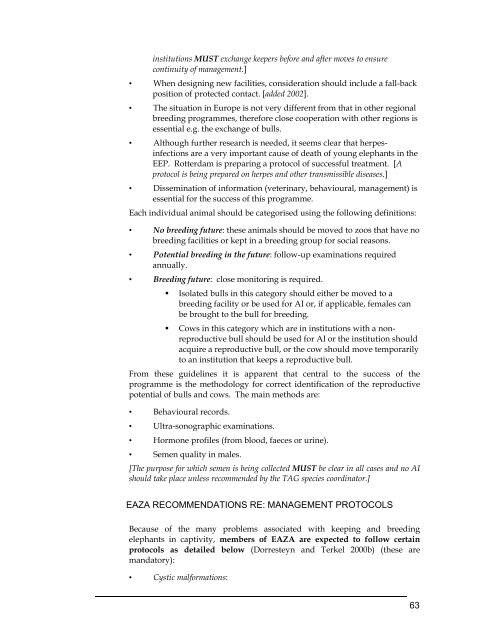Elephants Elephants - Wildpro - Twycross Zoo
Elephants Elephants - Wildpro - Twycross Zoo
Elephants Elephants - Wildpro - Twycross Zoo
Create successful ePaper yourself
Turn your PDF publications into a flip-book with our unique Google optimized e-Paper software.
institutions MUST exchange keepers before and after moves to ensure<br />
continuity of management.]<br />
• When designing new facilities, consideration should include a fall-back<br />
position of protected contact. [added 2002].<br />
• The situation in Europe is not very different from that in other regional<br />
breeding programmes, therefore close cooperation with other regions is<br />
essential e.g. the exchange of bulls.<br />
• Although further research is needed, it seems clear that herpesinfections<br />
are a very important cause of death of young elephants in the<br />
EEP. Rotterdam is preparing a protocol of successful treatment. [A<br />
protocol is being prepared on herpes and other transmissible diseases.]<br />
• Dissemination of information (veterinary, behavioural, management) is<br />
essential for the success of this programme.<br />
Each individual animal should be categorised using the following definitions:<br />
• No breeding future: these animals should be moved to zoos that have no<br />
breeding facilities or kept in a breeding group for social reasons.<br />
• Potential breeding in the future: follow-up examinations required<br />
annually.<br />
• Breeding future: close monitoring is required.<br />
� Isolated bulls in this category should either be moved to a<br />
breeding facility or be used for AI or, if applicable, females can<br />
be brought to the bull for breeding.<br />
� Cows in this category which are in institutions with a nonreproductive<br />
bull should be used for AI or the institution should<br />
acquire a reproductive bull, or the cow should move temporarily<br />
to an institution that keeps a reproductive bull.<br />
From these guidelines it is apparent that central to the success of the<br />
programme is the methodology for correct identification of the reproductive<br />
potential of bulls and cows. The main methods are:<br />
• Behavioural records.<br />
• Ultra-sonographic examinations.<br />
• Hormone profiles (from blood, faeces or urine).<br />
• Semen quality in males.<br />
[The purpose for which semen is being collected MUST be clear in all cases and no AI<br />
should take place unless recommended by the TAG species coordinator.]<br />
EAZA RECOMMENDATIONS RE: MANAGEMENT PROTOCOLS<br />
Because of the many problems associated with keeping and breeding<br />
elephants in captivity, members of EAZA are expected to follow certain<br />
protocols as detailed below (Dorresteyn and Terkel 2000b) (these are<br />
mandatory):<br />
• Cystic malformations:<br />
63

















